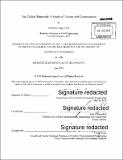The Collier Memorial : a study of theory and construction
Author(s)
Lyon, Nathaniel Angus
DownloadFull printable version (20.84Mb)
Other Contributors
Massachusetts Institute of Technology. Department of Civil and Environmental Engineering.
Advisor
John Ochsendorf.
Terms of use
Metadata
Show full item recordAbstract
The Collier Memorial is a vaulted stone structure that was built on the campus of the Massachusetts Institute of Technology during the fall of 2014 and the spring of 2015. In the course of the last century, structural engineers have almost fully abandoned the practice of masonry vaulting. The the Collier Memorial is a particularly interesting structure, because it spans not only space but also time, to an age that appreciated permanence in structure, an ideal befitting a memorial. This study's main goal was to equip the construction team with real-time validation of the Collier Memorial's performance during the most critical phase of construction-the lowering of the vault. This was accomplished by using a simple analytical approach to predict how loads and deformations would evolve at every stage of the lowering process. Using the lower-bound theorem of plastic theory, thrust line analysis was performed assuming global equilibrium was satisfied among the five legs. Jack loads were predicted using simple two-dimensional equilibrium while the deformations were predicted considering the structure to behave as a series of straight elastic bars that are oriented along the line of thrust and experience an axial force equal to the assumed thrust force. By choosing to predict the performance in addition to monitoring it, the team had the opportunity to test how their understanding of equilibrium applied to the structural performance of a modem masonry structure. Working with an accurate prediction of the performance, the hope was that the structure would carry as much of its own weight as possible before being grouted, so that the small amount of reinforcing steel would be only minimally engaged and thus pose a minimal threat to fracturing the stones in the future. By comparing the theoretical results and physical monitoring data, it was found that there was very little construction error, and this condition laid the path for shedding 96% of the vault load in the scaffolding and developing joint openings less than 1mm prior to grouting. Ultimately, this study demonstrates that simple hand calculations are capable of producing accurate solutions to complex problems. Given these results, the future of masonry vaulting could be brighter than its more recent past, as the legitimacy of its structural and historical merits outweigh any belief that this type of construction has somehow become inferior due to modern advancements.
Description
Thesis: M. Eng., Massachusetts Institute of Technology, Department of Civil and Environmental Engineering, 2015. Cataloged from PDF version of thesis. Includes bibliographical references (page 105).
Date issued
2015Department
Massachusetts Institute of Technology. Department of Civil and Environmental EngineeringPublisher
Massachusetts Institute of Technology
Keywords
Civil and Environmental Engineering.